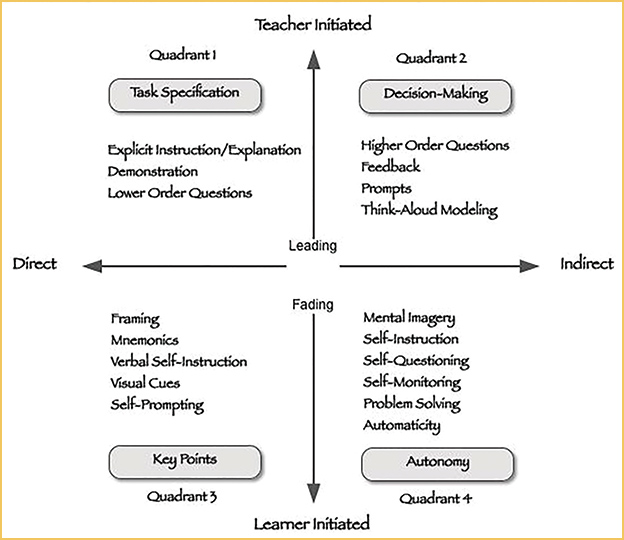Leading Students from Supported Instruction to Responsible Independence
“You’re On Your Own!!!”
Margaret Foster MAEd
Attention Magazine December 2019
An Approach to Leading Students from Supported Instruction to Responsible Independence
 “I’VE SHOWN THEM HOW TO DO IT, now they’re on their own!” You’ve heard yourself say it, I’ve heard myself say it. Or I’ve shouted it silently in my head.
“I’VE SHOWN THEM HOW TO DO IT, now they’re on their own!” You’ve heard yourself say it, I’ve heard myself say it. Or I’ve shouted it silently in my head.
At times, it’s the right thing to say, but most often our students need much more. They need instruction and practice. Practice and monitoring. Monitoring and strategies. And repetition.
Their faltering movements toward independence can be frustrating for sure, but it is essential for real learning. Whether it’s reading, writing, or organization, it helps if we re-focus on student learning as opposed to teaching and consider a simple continuum that leads from supported instruction to responsible independence.
As a learning specialist, I have been helping students surmount this process we call learning for… let’s just say a few decades, and I learn something new every year. But one of the approaches that has truly helped my students succeed every time is the Four-Quadrant Model of Facilitated Learning. A bit of a mouthful, it was first published by a pair of Australian occupational therapists (see the references at the end), and then modified by a pair of practitioners in the United States––psychologist Joyce Cooper-Kahn and me. We like the way this model simplifies the learning and performance process and allows us to track its progress.
A quick look at the model shows how learning and performance progresses over four quadrants. It demonstrates the steps toward independence as it moves from teacher-initiated to learner-initiated tasks, and from direct to indirect guidance. It begins with Direct Instruction in quadrant 1, moving to Autonomy in quadrant 4. But wait––what’s all that stuff in between? That’s where the gold is and where the important movement happens!
Let’s look at an example.
Say you’re trying to teach a student to use their planner effectively: An adult usually needs to help them purchase the planner and suggest ways to get it from home to school, initially. But what if that doesn’t work over time? What if getting the planner from home to school is such a challenge that actual planner use is a pipe dream? Then focus on the task of planner transport in order to get to planner use. Using the Four-Quadrant Model we know we need to:
- Instruct the student about what to do and how to do it. For example: “Remember, your homework isn’t complete until you put your planner into your backpack.”
- Monitor them closely as they practice this routine using guiding questions. Perhaps, “Is your homework done… What all does that include?”
- Provide a designated time and opportunity in their schedule for packing up the planner, which primes the routine. Sometimes an adult standing in proximity to the “packing up” helps prime the routine as well.
- Provide time and opportunity to enable them to do it independently and ask for help, if needed. Notice, autonomy still requires the instructor to play a part.
This seems simple enough, but step two (guided practice) and step three (monitored practice) are most often skipped in a busy classroom or home. It’s true that some students, in some situations, can do these things automatically with little guidance. But, if we believe that learning problems are real, then we have to assume that any student may need to go through these steps more consciously in some situations.
Let’s dig a little deeper into this four-quadrant model to see another way it can play out. You can use the steps listed above to guide you, or the “words spoken” cues below to help you distinguish where you are along the continuum.
Words spoken:
Quadrant 1: “Listen, watch, let me show you…”
Example: “Let’s all take out the paragraph we’re reading and use highlighters to do a ‘close read’ together.” Quadrant 2: “How will you…?” “What will you use…?” “What should you do when…?”
Example: “Now that we’ve walked through the “close read” steps together on the first paragraph, what will you do on the second? How will you know if you’re highlighting too much or too little? What questions do you think this paragraph will address.” Quadrant 3: “Have you thought through the steps you will need in order to…?”
Example: ‘We’ve been practicing ‘close reads’ for three days now, what steps will you employ today to accomplish it on your own?” Quadrant 4: “Way to go! I love the way you just…”
Example: “I reviewed the work you did on your own yesterday, and would like to review the very effective strategies I saw.” OR “In partners, share your work from yesterday and be prepared to give examples of what worked and why.”
IMPORTANT: Most instructors and parents are fairly talented when it comes to Quadrant 1 and 4, but when in a hurry, or with more talented processors in the group, we often skip parts 2 and 3. And, you should know, as a learning specialist I probably spend a full 80% of my coaching time on Quadrant 2! It is THE most essential bridge needed to move from dependence to independence.
Okay, so what if we’re not teaching reading and how to do a “close read?” Here is another example that touches on some of the executive skills that trip up students of all ages.
EXAMPLE: MOVING THROUGH A RESEARCH PROJECT OR A LONG WRITING ASSIGNMENT
Words spoken: “Your research/writing project is due at the end of the month.”
Quadrant 1, Direct Instruction: The teacher will present the project, steps and examples to the students IN WRITING as well as orally. Parents may need a copy of the same to help their children plan their time wisely. Asking students to fasten it in their planner is one way of accomplishing both.
Quadrant 2, Prompting: This requires dedicated class time to get students to reflect on their timing, their work and their next steps using guided questions and monitoring.
Quadrant 3, Priming, requires that the teacher provide time and space to continue to reflect, plan, and work with less direct intervention. Partner work is often useful here and leaves the teacher free to monitor.
Quadrant 4, Independence, rarely occurs within a single research project––it generally requires two or three rounds of the same kind of project before the student can anticipate and self-monitor the steps needed in a more fluid manner. Assigning only one research project per year pretty much assures that the student will forget how to proceed along the steps needed, due to the lack of practice and opportunities to generalize. That said, working through smaller projects is a nice way to scaffold the processes needed to succeed in the larger ones. This is NOT the same as instructing students as they move through each step of the assignment. Though this may be useful in terms of completing the project, it doesn’t necessarily lead toward independence as the executive skills have not been employed, shaped, practiced, and self-monitored.
Not included in the four-quadrant model toward independence: “Stop by my room after school and I’ll set up your calendar for you.” Or, “Why don’t you skip this part and do the rest.” While these may be useful accommodations to alleviate anxiety or bypass skills that have not yet been mastered, it is not considered a step toward independence unless these meetings are later paired with quadrant 2 questions and quadrant 3 primings.

FROM COOPER-KAHN AND FOSTER, 2013, P. 133. MODEL ADAPTED WITH PERMISSION FROM GREBER, ZIVIANI AND RODGER, 2007.
A parting note to educators
Okay now, you’re on your own! Now you have the instruction and advice you need to help students move toward independence…
And, I hope you caught me in that lie.
If you really want to move your students toward independence, you too will need someone to help you with guided practice, monitoring, and self-reflection. So grab a partner or a mentor and work on this together––we teachers and parents need support to build independence, too.
Tear-Out Sheet
Quadrant 1: Direct instruction and demonstration
“Listen, watch, let me do it with you…” Quadrant 2: Guided practice and decision-making
“How will you…? What will you use…? What should you do when…?” Quadrant 3: Priming and self-prompting
“Have you thought through the steps you will need in order to…?” Quadrant 4: Autonomy, problem solving, and self-monitoring
“Way to go! I love the way you…” or,
[The sound of crickets]
Margaret Foster, MAEd, is the director, learning specialist, and academic coach at Educonn, LLC. She helps students of all ages understand their academic challenges and guides them as they plan and practice individualized strategies for success. Foster has written numerous articles about executive functioning and coauthored a book for teachers with Joyce Cooper-Kahn, PhD, Boosting Executive Skills in the Classroom. She also provides professional development for schools and organizations about reading, writing, and executive skills.
REFERENCES
Cooper-Kahn, J. and Foster, M. (2013) Boosting Executive Skills in the Classroom: A Practical Guide for Educators. San Francisco, CA: Jossey Bass.
Greber, C., Ziviani, J., and Rodger, S. “The Four-Quadrant Model of Facilitated Learning (Part 2): Strategies and Applications,” Australian Occupational Therapy Journal, 2007, 54(Suppl.1), S4

